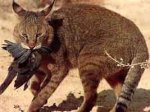 The population of Jungle cats (Felis chaus) is significant in India (and adjacent nations), but is recognized by just a singular historical specimen from Vietnam or Cambodia. At Indochina, all the other small/medium cats are noted more often than the Jungle Cats. Habitat survival (read: adapting) in other areas would allow a better conservation status if man's hunting could be cut down considerably. Sadly, they are frequently killed by man, and maybe we could not blame them (the humans)...these cats have been known to kill livestock too.
The population of Jungle cats (Felis chaus) is significant in India (and adjacent nations), but is recognized by just a singular historical specimen from Vietnam or Cambodia. At Indochina, all the other small/medium cats are noted more often than the Jungle Cats. Habitat survival (read: adapting) in other areas would allow a better conservation status if man's hunting could be cut down considerably. Sadly, they are frequently killed by man, and maybe we could not blame them (the humans)...these cats have been known to kill livestock too.The Jungle Cat is active during the day, and they have a shelter to take refuge in if a rest is needed. Breeding season for the Jungle Cat depends on the range actually. At the north parts, they mate during the winter da
ys, but if they are in the south areas, they could mate at any time within the year. When gestating is through (2 months), one to six kittens come out. When the newborn reaches 8 weeks old, they are weaned, and at about
6 months old, they could be segregated from the female parent. These cats are solitary by nature, and when resting, one would twist the forefeet and put them under its body.
Let us go to the Jungle Cat's food habits, they eat small mammals, hares, snakes, birds, frogs and lizards.
In the mating season, a male would bark, in a dog-like fashion.
The Jungle cat, reed cat, swamp cat is listed as Least Concern. Does not qualify for a more at risk category. Widespread and abundant taxa are included in this category, on the IUCN Red List of Threatened Species
Namings for the jungle cat
A young / baby of a jungle cat is called a 'kitten'. The females are called 'queen' and males 'tom '. A jungle cat group is called a 'clowder, clutter, pounce, kindle (young), embarrassment (young),'.Countries
Afghanistan, Bhutan, Burma, Cambodia, China, Egypt, India, Iran, Iraq, Israel, Jordan, Kazakhstan, Kyrgyzstan, Laos, Mongolia, Nepal, Pakistan, Russia, Sri Lanka, Syria, Tajikistan, Thailand, Turkey, Turkmenistan, Uzbekistan and VietnamJungle cat habitats
Desert, Dry savanna, Forest, Hot Desert, Savanna, Shrubland, Subtropical / Tropical Dry forest, Subtropical / Tropical Dry Shrubland, Temperate Desert and Temperate forestSome facts about the
Jungle cat
Adult weight : 10 kg (22 lbs)
Maximum longevity : 20 years
Female maturity :335 days
Gestation : 60 days
Weaning : 90 days
Litter size : 3
Litters per year : 2
Interval between litters : 112 days
Weight at birth : 0.131 kg (0.2882 lbs)
Weight at weaning : 2.213 kg (4.8686 lbs)

Custom Search